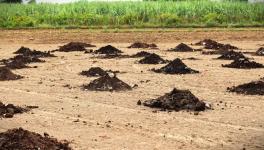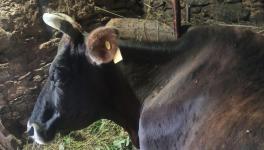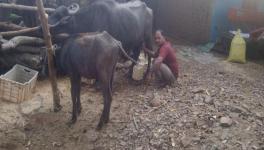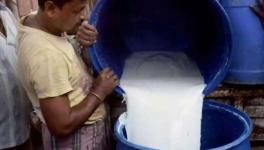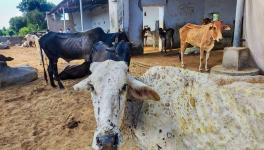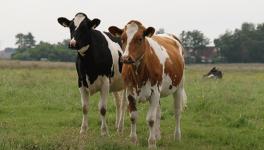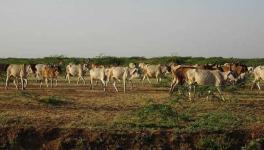Lumpy Virus has an Alarming Past, Govts Must Act
Representational use only.Image Courtesy: NDTV
The lumpy skin disease virus (LSDV) made it to a mainstream daily's editorial on September 7, some three months after the deadly disease first broke out in Gujarat. Citing 11.25 lakh infected cattle and 50,000 deaths, the editorial lamented how "there seems to be no coordinated national effort for dealing with what is clearly more than a normal viral outbreak."
No concerted efforts by governments would mean that the milk economy takes a beating. Already we have seen how Gujarat has suffered a drop in yield of about 50,000 litres/day and how officials in Punjab have admitted a drop in production by 15-20%. Indeed, as the dairy sector contributes one-fifth of the gross value added (GVA) to Indian agriculture, matters can rapidly get from bad to worse.
The experiences of sister outbreaks elsewhere are a good reference point to understand the frightening impact of LSDV.
India's tryst with the cattle-killer disease is similar to its first recorded impact in the African continent, when it spread from Zambia (then Northern Rhodesia) in 1929 to several southern African countries by 1940 and leaving Libya, Algeria, Morocco, and Tunisia, covered the entire continent in few decades. Some countries, like Egypt, have seen two outbreaks, the first in 1988 and the second in 2006. Middle-eastern countries like the United Arab Emirates, Israel, Yemen, Lebanon, and Kuwait have also come under LSDV's grip in the past decades.
According to a review paper from the Institute of Animal Health, Surrey, United Kingdom, the disease spread swiftly in each of the above cases despite an extensive vaccination campaign. The leading cause identified behind the pace of advance was the maintenance of dense cattle populations in relatively small areas located mainly on river deltas and basins and uncontrolled animal movements across grazing lands.
When we look at the Indian situation, the menace of stray cattle comes to mind. Farmers have repeatedly accused the authorities of allowing cattle to breed uncontrolled through gaushalas and the ban on cattle slaughter. Indeed, crop damage by stray cattle was so widespread that it became a point of political contestation between the ruling party and the opposition in Uttar Pradesh earlier this year.
The cattle slaughter ban in various states also has consequences for disease control. One can look at regulations in other countries. For instance, the European Economic Community (EEC), which has notified LSDV, notes that should an outbreak occur, the regulation would require the slaughter of affected and in-contact animals. The operating procedure also requires the implementation of a 3 km protection zone and a 10 km surveillance zone around the infected premises. Three disease-free years are required for a country to regain an official disease-free status that underlines the economic severity of an outbreak.
Further, the paper, published in Transboundary and Emerging Diseases in 2011, noted that successful transmission of LSDV occurs when naive (healthy) cattle are allowed to share a drinking trough with severely infected animals. Currently, India's livestock density is high, with Uttar Pradesh and Rajasthan topping the charts for cattle population at 6.8 crore and 5.8 crore, respectively, followed by Madhya Pradesh at 4 crore, Maharashtra at 3.3 crore and Karnataka at 2.9 crore. This implies a high probability of transmission of LSDV from infected cattle to healthy ones through a sharing of water resources.
The paper also noted an alarming fact about LSDV: the morbidity rate can vary from 3% to as high as 85%, depending on the immune status of the infected host. The 2006 Israel outbreak noted a morbidity rate of 41.6%. With the virus spreading to 12 states and 165 districts of India, it is reasonable to expect the number of cattle deaths to shoot up steeply in the coming days.
Fatalities are not the only worry here. The paper notes how during the outbreak of LSDV in Egypt in 2006-7, as high as 93% of infected female cows suffered from ovarian inactivity. Deteriorating fertility would mean an absolute reduction in the number of cattle in the country, hurting small dairy farmers who depend on natively breeding their cattle to continue their economic activity.
Resentment among farmers is brewing, and that, not the mainstream paper's editorial, is a true signifier of how bad the situation has already become.
FARMERS CONTEST GOVT CLAIMS
There have been reports of farmer resentment over various state governments' mishandling of the developing LSDV crisis. The Hindu reported last week how LSDV was spreading like wildfire in Western Uttar Pradesh.
"There is no intervention from the government. There is no compensation for farmers who lost their cows and buffaloes. There is no treatment or vaccination. Those who do cattle-rearing are forced to manage this disease on their own," said a farmers' leader from Shamli, Jitender Singh Hudda. He added that they would launch protests if the administration continued to neglect the situation. "Hundreds of cows are infected. Deaths are also on the rise. It is an emergency situation," Hudda said.
On the other hand, UP's livestock minister Dharam Pal Singh was quoted as saying all the borders had been blocked, and transport, sale, trade and cattle trade fairs had been banned.
"Particular attention has been given to districts like Saharanpur, Meerut and Bijnore. The farmers have been advised on the precautions to be adopted at cattle sheds. Vaccination has started. Gaushalas will be given priority in the process," Singh said.
Farmers still maintain that the government is not doing enough.
Chandrapal Singh, who is into cattle-rearing and is also an All India Kisan Sabha activist from Bulandshahar, close to Gautam Buddh Nagar district, told The Hindu, "The spread is very high here, particularly among cows. There is no governmental aid. Vaccines and doctors are not available. There is not a single village that's not affected by the LSDV in our locality. Cows will have big abscesses on their skins along with fever, and they will die. Authorities told us that they do not have proper facilities. About 15-20 villages have one veterinary doctor. They just asked us to create space between the cows. We had complained to the authorities, but it is of no use. In my village, about 30 cows have died. Milk production has come down."
In Punjab, dairy farmers have already begun protests against their state government. Under the banner of the Samyukta Kisan Morcha (SKM), they staged a protest outside the residences of the Cabinet Ministers from the Amritsar district, demanding fair compensation for the loss of animals due to LSDV on September 5.
Dr Satnam Singh Ajnala, who led one of the protests, was quoted by The Tribune, stating, "A hybrid cow costs over Rs 1 lakh. Many farmers have lost more than one animal, and some have even lost four or five cows." He said the farmers would not be able to recover from the loss unless the government came to their aid.
In Himachal Pradesh, farmers from Mashobara and Basantpur blocks associated with the Himachal Kisan Sabha have accused the state animal husbandry department and disaster management authority of making contradictory statements. They say that while the former has termed the LSDV outbreak an epidemic, the latter has refused to do so. The result has been the rules for awarding compensation, and the extent of compensation to dairy farmers is still unclear, even as 500 cattle are infected daily.
Now, reports are coming that a fresh wave of viral infection of LSDV in cattle has spread to newer geographical areas of Maharashtra and Madhya Pradesh.
LSDV first forayed into India in August 2019, when sporadic cases were discovered on the eastern seaboard around Orissa. It is possible that during the COVID-19 pandemic, hard-pressed authorities could not trace the virus's advance. Gradually, it traversed the breadth of the country and reached Gujarat, where in May this year, the first outbreak took place.
Get the latest reports & analysis with people's perspective on Protests, movements & deep analytical videos, discussions of the current affairs in your Telegram app. Subscribe to NewsClick's Telegram channel & get Real-Time updates on stories, as they get published on our website.









